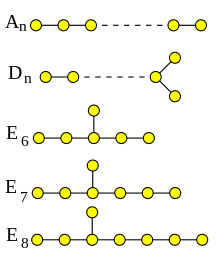related classifications(3)---Dynkin diagramディンキン図形20180305 のつづき・・・
The index (the n 「指数」化方式?? ) equals to the number of nodes in the diagram, the number of simple roots in a basis, the dimension of the root lattice and span of the ”root system '', the number of generators of the Coxeter group, and the rank of the Lie algebra. However, n does not equal the dimension of the defining module (a fundamental representation基礎[本?]的-表現???<'<In representation theory of Lie groups and Lie algebras, a fundamental representation is an irreducible finite-dimensional representation of a semisimple Lie group or Lie algebra whose highest weight is a fundamental weight. For example, the defining module of a ''classical Lie group"'典型的リー群?!? is a fundamental representation. Any finite-dimensional irreducible representation of a semisimple Lie group or Lie algebra can be constructed from the fundamental representations by a procedure due to Élie Cartan. Thus in a certain sense, the fundamental representations are the elementary building blocks for arbitrary finite-dimensional representations.(これも、?けっきょく・まわりくどく??「1, 」をせつめいしているだけ ?!?!?, ) >,,>) of the Lie algebra ? the index on the Dynkin diagram should not be confused with the index on the Lie algebra. For example, B _4 corresponds to s o _{2 ・ 4 + 1} = s o _9 , which naturally acts on 9-dimensional space(Dynkin diagram? ), but has rank 4 as a Lie algebra.
The simply laced Dynkin diagramsいままでの数学的ひょうげんほうほうにないもの・として・あらたにつくりだされてもの ??? , those with no multiple edges (A, D, E) classify many further mathematical objects; see discussion at "'ADE classification '''<'~ In athematics, the ADE classification (originally A-D-E classifications) is the complete list of simply laced Dynkin diagrams or other mathematical objects satisfying analogous axioms; "simply laced" means that there are no multiple edges, which corresponds to all simple roots in the root system forming angles of π / 2 = 90° or 2 π /3 = 120° (single edge between the vertices). The list comprises
A _n , D _n , E _6 , E _7 , E _8 .
These comprise two of the four families of Dynkin diagrams (omitting B _n and C _n , and three of the five exceptional Dynkin diagrams (omitting F _4 and G _2 ).
This list is non-redundant if one takes n ≥ 4 for D _n. If one extends the families to include redundant terms, one obtains the exceptional isomorphisms
D _3 ≅ A _3 , E _4 ≅ A _4 , E _5 ≅ D _5 ,
and corresponding isomorphisms of classified objects.
The question of giving a common origin to these classifications, rather than a posteriori verification of a parallelism, was posed in (Arnold 1976).
The A, D, E nomenclature also yields the simply '''lacedからみあうような?? finite Coxeter groups"", by the same diagrams: in this case the 'Dynkin diagrams" exactly coincide with the ''Coxeter diagrams", as there are no multiple edges.
(規則性がない?(ちつじょがない?,)?) ようなものをつくりだし'computers 『(A.I. 人工知能 )』かんり・とうかつ??・うんよう' みたいなことを・しようと・している ??? ??,
>.
 <figure--ADE classification >
<figure--ADE classification >
The 'simply laced Dynkin diagrams'' classify diverse多種多様?!? mathematical objects.
by Wikipedia
(これらの同型は単純・半単純リー環の同型に対応し、リー群の同型にも対応する. 図形の例外同型 を、そしてリー環と付随するリー群の対応する例外同型. ・・・ 「異なる図形の間の同型に加えて、いくつかの図形は自分自身への同型すなわち「自己同型」も持つ. 図形自己同型はリー環の外部自己同型 に対応する、つまり、外部自己同型群 Out = Aut/Inn は図形の自己同型の群に等しい 」につづく?,・・ )
